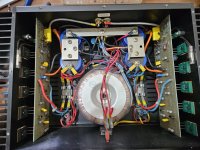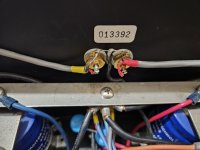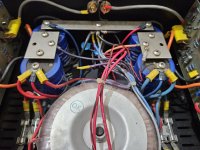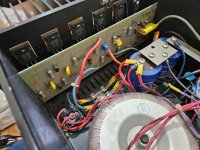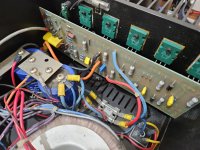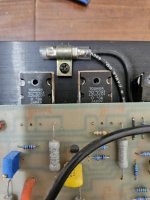If you can find the metal package - 2N5566 - it can be used. The plastic package was used in lots of Nelson Pass gear (I always remembered the op amp number by thinking "Nelson Pass Device 5566) 😉
I bought several original NPD5566 years ago for other gear, and Nelson kindly gave me a couple for my Forte. You might be lucky if you ask Nelson.
@dastinger - don't rule out the op amp as a potential cause.
I bought several original NPD5566 years ago for other gear, and Nelson kindly gave me a couple for my Forte. You might be lucky if you ask Nelson.
@dastinger - don't rule out the op amp as a potential cause.
The thing that leads me to believe it's merely a matter of cold solder joints is the fact that tapping the left side of the amp fixes the issue. Until it happens again ofc.@dastinger - don't rule out the op amp as a potential cause.
Where on the amp are you tapping - the heat sink, the top, etc.?
Sounds reasonable, but before you start pulling the boards off the heat sinks, first check to see if the speaker terminal connections are loose. Then, make sure the input RCA jack ground connections are good.
Also, check the carbon comp cap on each board.
Sounds reasonable, but before you start pulling the boards off the heat sinks, first check to see if the speaker terminal connections are loose. Then, make sure the input RCA jack ground connections are good.
Also, check the carbon comp cap on each board.
I usually tap the heatsink for the left channel. Also, what is being described in this thread is exactly what mine is doing. That, linked to the fix by tapping leads me to believe it's cold solder joints. But, of course, this is not scientific at all, so I'll definitely do what you suggest. Thank you once again!
Once I pulled the circuit boards, it became a circus. About the time that I put everything back together I had caused some new problems of my own. In short, I will say that the boards themselves are not made as beefy as I would like. That is when my friend stepped in. The amp would have set for years more if it hadn't been for him.
Hey guys!
So, I went in and did a couple of things after disassembling the left channel board:
I have a question though. I'm not an expert, and I don't know if my assumption is correct, but is there anything else I should have done when using the DMM to check the caps or is checking for capacitance enough? I mean, I find it weird that an amp that's almost 40 years old has all its original caps in apparent perfect condition. There is a really low hum (around 100hz) in the signal, so something is definitely not 100% right, but since it's almost inaudible, I haven't cared much. I was ready to go ahead and replace the 4 big caps, but now I'm not sure if I should.
Opinions? @GKTAUDIO @Ixnay
So, I went in and did a couple of things after disassembling the left channel board:
- I desoldered and checked every capacitor on the board for capacitance. They all checked out fine;
- Did the same with the big filter capacitors. They're 24.000 microfarads and my DMM only goes up to 20 millifarads (=20.000 microfarads if I got the math right). Considering that, my DMM maxed out at 20m which means that if they're not right, they're pretty close to the ~24m they should measure;
- Redid the solders that didn't look good. One in particular was cracked and maybe that was the culprit. Not sure if it cracked during disassembly though.
I have a question though. I'm not an expert, and I don't know if my assumption is correct, but is there anything else I should have done when using the DMM to check the caps or is checking for capacitance enough? I mean, I find it weird that an amp that's almost 40 years old has all its original caps in apparent perfect condition. There is a really low hum (around 100hz) in the signal, so something is definitely not 100% right, but since it's almost inaudible, I haven't cared much. I was ready to go ahead and replace the 4 big caps, but now I'm not sure if I should.
Opinions? @GKTAUDIO @Ixnay
Last edited:
Papa designed this. I recall asking him on this forum about the bias, he forgot, but said 15mV or 40C on the sinks with no signal after 10 minutes, whatever is higher. I think I ended up with 26mV if memory serves. Since this design was also used in the 50w class A model (lower rails) it is design to be very tolerant of higher bias values... I did try to over 100mV and got the sinks to 55C .... Papa said they should be fine till 65C... never got it that high myself...
If you have gone into the amp that deep, there is no reason not to change the caps. They are inexpensive, and the hum that you are talking about could very well be from one of them. After all, if you intend to run this amp at temp, and are already there, I can't see a reason not to make this move.
Thanks a lot @Ixnay !
True, but I measured them and they're up to spec. Is there an actual reason to replace them given the fact that they're apparently healthy, at least capacitance wise? They're not that inexpensive. The small ones on the board yes, but the 4 power supply caps at 24.000 microfarads cost at least €22 + 23% VAT each. And those are also apparently up to spec as well. I just don't want to be replacing stuff that seems to be ok. But I'm no expert, so I may be missing something here. Please bear with me.
@K-amps thanks, that's good info!
True, but I measured them and they're up to spec. Is there an actual reason to replace them given the fact that they're apparently healthy, at least capacitance wise? They're not that inexpensive. The small ones on the board yes, but the 4 power supply caps at 24.000 microfarads cost at least €22 + 23% VAT each. And those are also apparently up to spec as well. I just don't want to be replacing stuff that seems to be ok. But I'm no expert, so I may be missing something here. Please bear with me.
@K-amps thanks, that's good info!
The power, well I actually would understand that more if they weren't replaced. They are much easier to get to. But when you have to tear something all the way down, it is better safe than sorry. 'Modern' caps probably have improved in some respects compared to 40 years ago. And as far as the IC used in that amp, it is also a good idea to solder in a socket for the reasons just mentioned. Your amp is a great amp. I still have mine, but it is mostly new inside.
@dastinger - Most of the gear I've worked on is between 25-35 years old. About 65% of the amplifiers have had main filter caps that measured good enough to avoid replacement, while the remainder either measured poorly or very poorly. There is, however, more to evaluating capacitor condition than just the capacitance.
If I understand correctly, the measured capacitance exceeded your meter's range. That means you can't be sure of the exact capacitance. In some cases, it may be within the tolerance range of the caps, which back in the day was often -10%, +40-75%. The trouble is that as they age, electrolytic caps often rise in capacitance, so a 22,000uF cap as measured new could now measure 10-20% higher, which could indicate a reduction in performance. One important test is ESR, because that tends to increase as caps age and begin to fail.
You could discharge and disconnect the caps and use an ESR meter, but cheap ones aren't that accurate. I've got several different capacitor meters and built one just for testing ESR at rated voltages up to 500V and it is accurate and informative.
Another approach is to use an oscilloscope to check for ripple at the capacitor (leading edge pips), but you will need to have experience safely using your scope on bipolar power supplies or you'll blow up your probe.
Unfortunately, before I was taught how to properly check main filter caps, I replaced a bunch in different amps that didn't need replacing, but I've also had amps with one good and one going bad cap, or two amps of the same make, model and vintage whose caps were in noticeably different condition.
With this amp, increasing capacitance a reasonable amount is not a problem and actually helps the sound, in my experience. Replacing 40-year old caps makes sense if you are going to keep the amp, maybe not if you are going to sell it, but in my view, it is imperative if you sell it as a functioning amp. The cost is not that high relative to the cost of other work/repair on an amp, and done properly will make the amp function well for many years to come. For perspective, when I replaced the filter caps in my Mark Levinson No. 27, the cost was $1,200 and I had to wait 9 months for a new production run. Turns out they are only made for ML repair shops.
If I understand correctly, the measured capacitance exceeded your meter's range. That means you can't be sure of the exact capacitance. In some cases, it may be within the tolerance range of the caps, which back in the day was often -10%, +40-75%. The trouble is that as they age, electrolytic caps often rise in capacitance, so a 22,000uF cap as measured new could now measure 10-20% higher, which could indicate a reduction in performance. One important test is ESR, because that tends to increase as caps age and begin to fail.
You could discharge and disconnect the caps and use an ESR meter, but cheap ones aren't that accurate. I've got several different capacitor meters and built one just for testing ESR at rated voltages up to 500V and it is accurate and informative.
Another approach is to use an oscilloscope to check for ripple at the capacitor (leading edge pips), but you will need to have experience safely using your scope on bipolar power supplies or you'll blow up your probe.
Unfortunately, before I was taught how to properly check main filter caps, I replaced a bunch in different amps that didn't need replacing, but I've also had amps with one good and one going bad cap, or two amps of the same make, model and vintage whose caps were in noticeably different condition.
With this amp, increasing capacitance a reasonable amount is not a problem and actually helps the sound, in my experience. Replacing 40-year old caps makes sense if you are going to keep the amp, maybe not if you are going to sell it, but in my view, it is imperative if you sell it as a functioning amp. The cost is not that high relative to the cost of other work/repair on an amp, and done properly will make the amp function well for many years to come. For perspective, when I replaced the filter caps in my Mark Levinson No. 27, the cost was $1,200 and I had to wait 9 months for a new production run. Turns out they are only made for ML repair shops.
Last edited:
Thank you so much @GKTAUDIO for chiming in. You have been of much help so far. Let me approach your reply in parts.
OK, given what you wrote, I found two sets of caps that should work, both from Kemet. Both are 33.000µF with a rating of 63v (the original ones are 24.000µF with a rating of 45v). I have a few questions if you don't mind answering:
1. I found two sets of caps, as I said:
This: https://mou.sr/47iyfbG
And this: https://mou.sr/4aHgKVn
(I hope it's ok to link to Mouser)
Both with the same capacitance and voltage rating. Looking at the datasheet, I can't figure out why one costs 50% more than the other. Would the cheapest ones work ok or would it be much better to use the most expensive?
2. Let's say I wanted to keep the repair cost as low as possible. What would you personally do:
- Skip the ESR meter and go straight to replacing the caps with the added risk of spending money unnecessarily;
OR
- Buy the ESR meter, measure and replace the caps if the ESR and actual capacitance reading are not up to spec.
3. The Peak ESR70 should be able to read these 24.000µF caps correctly, right? Do you know of any cheaper meter that is good enough?
4. I'd like to avoid disassembling the whole amp again, but do you think the other smaller caps on the boards could also benefit from a proper ESR reading? Are they prone to failing with age just as the electrolytic?
I'm sorry for so many questions, but I really want to get this one right. I want to keep the amp as my main amp for many years so I'd like it to run as well as possible.
Thank you very much for all your help, everyone!
Yes, the measured capacitance exceeded my meter's range. The capacitors are 24 millifarads (24000 microfarads) and my meter only reads up to 20 millifarads. I didn't know that failing capacitors could read higher than they should so I thought that the fact that they reached a reading close to 24000µF was a good indication of their health. I was wrong.If I understand correctly, the measured capacitance exceeded your meter's range. That means you can't be sure of the exact capacitance. In some cases, it may be within the tolerance range of the caps, which back in the day was often -10%, +40-75%. The trouble is that as they age, electrolytic caps often rise in capacitance, so a 22,000uF cap as measured new could now measure 10-20% higher, which could indicate a reduction in performance. One important test is ESR, because that tends to increase as caps age and begin to fail.
I know about testing ESR, but I don't have a meter for that. From what I gathered, one of the best in the market is the Peak ESR70, but it's around €100. So let's say that I spend €100 on the meter (that I won't use that much since this is kind of an isolated DIY approach) and then realise I also need to spend another €100+ on the caps. It starts to get costly.You could discharge and disconnect the caps and use an ESR meter, but cheap ones aren't that accurate. I've got several different capacitor meters and built one just for testing ESR at rated voltages up to 500V and it is accurate and informative.
Another approach is to use an oscilloscope to check for ripple at the capacitor (leading edge pips), but you will need to have experience safely using your scope on bipolar power supplies or you'll blow up your probe.
Wow, mental note: do not buy Mark Levinson amps 😆With this amp, increasing capacitance a reasonable amount is not a problem and actually helps the sound, in my experience. Replacing 40-year old caps makes sense if you are going to keep the amp, maybe not if you are going to sell it, but in my view, it is imperative if you sell it as a functioning amp. The cost is not that high relative to the cost of other work/repair on an amp, and done properly will make the amp function well for many years to come. For perspective, when I replaced the filter caps in my Mark Levinson No. 27, the cost was $1,200 and I had to wait 9 months for a new production run. Turns out they are only made for ML repair shops.
OK, given what you wrote, I found two sets of caps that should work, both from Kemet. Both are 33.000µF with a rating of 63v (the original ones are 24.000µF with a rating of 45v). I have a few questions if you don't mind answering:
1. I found two sets of caps, as I said:
This: https://mou.sr/47iyfbG
And this: https://mou.sr/4aHgKVn
(I hope it's ok to link to Mouser)
Both with the same capacitance and voltage rating. Looking at the datasheet, I can't figure out why one costs 50% more than the other. Would the cheapest ones work ok or would it be much better to use the most expensive?
2. Let's say I wanted to keep the repair cost as low as possible. What would you personally do:
- Skip the ESR meter and go straight to replacing the caps with the added risk of spending money unnecessarily;
OR
- Buy the ESR meter, measure and replace the caps if the ESR and actual capacitance reading are not up to spec.
3. The Peak ESR70 should be able to read these 24.000µF caps correctly, right? Do you know of any cheaper meter that is good enough?
4. I'd like to avoid disassembling the whole amp again, but do you think the other smaller caps on the boards could also benefit from a proper ESR reading? Are they prone to failing with age just as the electrolytic?
I'm sorry for so many questions, but I really want to get this one right. I want to keep the amp as my main amp for many years so I'd like it to run as well as possible.
Thank you very much for all your help, everyone!
1. I'd be happy with the less expensive ones. Both are rated at 18,000 life span (wow). The more expensive ones have higher ripple current handling and lower ESR, but are 23mm taller, so you need to check vertical clearance. I don't think you need the lower ESR and higher ripple current in this amp, particularly because both are better at this capacitance than with an old cap of lower capacitance. I normally try to go with a higher voltage rating, as long as the cap still fits (usually do, because caps have gotten smaller).
2. Your situation is completely different from mine. I like to accumulate test equipment and tools, since I'm trying to increase my abilities as I work on and build more gear. For you - I'd just replace them. Why have a piece of gear you'll never use again, particularly if you find the caps need replacement?
3. I don't have the ESR70 but the other meters I have in this price range are nowhere near as accurate as my equipment that tests at the operating or rated voltages.
4. The film caps are not prone to failing at rates approaching electrolytics. Mylar caps (the green ones) have higher distortion than some other caps, but for you, I'd say, don't bother. You haven't indicated that you want amp repair and updates to become your new hobby, so don't take a chance on damaging a working amp for questionable results. You won't have ESR issues with film caps, by the way.
2. Your situation is completely different from mine. I like to accumulate test equipment and tools, since I'm trying to increase my abilities as I work on and build more gear. For you - I'd just replace them. Why have a piece of gear you'll never use again, particularly if you find the caps need replacement?
3. I don't have the ESR70 but the other meters I have in this price range are nowhere near as accurate as my equipment that tests at the operating or rated voltages.
4. The film caps are not prone to failing at rates approaching electrolytics. Mylar caps (the green ones) have higher distortion than some other caps, but for you, I'd say, don't bother. You haven't indicated that you want amp repair and updates to become your new hobby, so don't take a chance on damaging a working amp for questionable results. You won't have ESR issues with film caps, by the way.
@GKTAUDIO
Got it! I'll most probably go ahead and replace the caps. I want to tackle that rather faint but kind of annoying 100hz hum I've got and feel that the amp is running as best as possible without spending a ton of money.
Your help is really appreciated, thank you so much! I'll make sure to update the thread once I go ahead with the filter caps replacement. Meanwhile, I'd like to contribute with some more pictures of the Forte Audio Model 3 in 95% original condition (replaced RCA inputs and bias pots only).
Got it! I'll most probably go ahead and replace the caps. I want to tackle that rather faint but kind of annoying 100hz hum I've got and feel that the amp is running as best as possible without spending a ton of money.
Your help is really appreciated, thank you so much! I'll make sure to update the thread once I go ahead with the filter caps replacement. Meanwhile, I'd like to contribute with some more pictures of the Forte Audio Model 3 in 95% original condition (replaced RCA inputs and bias pots only).
Attachments
You are welcome @dastiner. Look at this way; cheaper to replace the caps than buy a new or upgraded amp, right?
Also, I see you have the yellow film caps, not the green mylars I've seen in others. I'd still leave them in. Same with the pretty high quality input film cap (large, yellow).
Cheers
Also, I see you have the yellow film caps, not the green mylars I've seen in others. I'd still leave them in. Same with the pretty high quality input film cap (large, yellow).
Cheers
Mine are yellow, too, and assume they are Mylar, so similar to the green ones, based on shape/configuration. Here's one with typical green mylar caps.

Adding 40,000uF of extra capacitance (especially if you choose the more expensive caps with only 10mOhms of ESR, which is exactly half of the cheaper ones - hence why the 20mOhm ESR version is much cheaper, by the way...) would put a lot of stress on the transformer, mains switch and bridge rectifiers.
The sound will change for sure... you may like it, but you may not... try and see. A lot will depend on the rest of your system and your personal listening preferences.
Large capacitance usually slows the sound... the ESR can jump substantially at higher frequencies, especially as the capacitance is increased.
The sound will change for sure... you may like it, but you may not... try and see. A lot will depend on the rest of your system and your personal listening preferences.
Large capacitance usually slows the sound... the ESR can jump substantially at higher frequencies, especially as the capacitance is increased.
- Home
- Amplifiers
- Pass Labs
- Forté Audio Model 3 Maintenance
